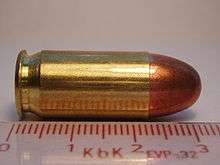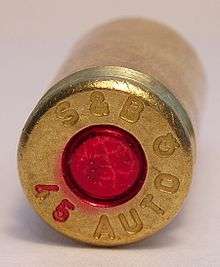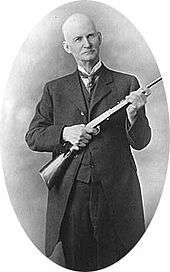.45 ACP
| .45 ACP | ||||||||||||||||||||||||
|---|---|---|---|---|---|---|---|---|---|---|---|---|---|---|---|---|---|---|---|---|---|---|---|---|
|
.45 ACP cartridges full metal jacket (left) and hollow-point (right). | ||||||||||||||||||||||||
| Type | Pistol | |||||||||||||||||||||||
| Place of origin | United States of America | |||||||||||||||||||||||
| Service history | ||||||||||||||||||||||||
| Used by | United States and others | |||||||||||||||||||||||
| Wars | World War I – present | |||||||||||||||||||||||
| Production history | ||||||||||||||||||||||||
| Designer | John Browning | |||||||||||||||||||||||
| Designed | 1904[1] | |||||||||||||||||||||||
| Variants | .45 ACP +P, .45 Auto Rim, .45 Super | |||||||||||||||||||||||
| Specifications | ||||||||||||||||||||||||
| Case type | Rimless, straight | |||||||||||||||||||||||
| Bullet diameter | .451 in (11.5 mm) | |||||||||||||||||||||||
| Neck diameter | .473 in (12.0 mm) | |||||||||||||||||||||||
| Base diameter | .476 in (12.1 mm) | |||||||||||||||||||||||
| Rim diameter | .480 in (12.2 mm) | |||||||||||||||||||||||
| Rim thickness | .049 in (1.2 mm) | |||||||||||||||||||||||
| Case length | .898 in (22.8 mm) | |||||||||||||||||||||||
| Overall length | 1.275 in (32.4 mm) | |||||||||||||||||||||||
| Case capacity | 25 gr H2O (1.6 cm3) | |||||||||||||||||||||||
| Rifling twist | 1 in 16 in (406 mm) | |||||||||||||||||||||||
| Primer type | Large or Small pistol | |||||||||||||||||||||||
| Maximum pressure (C.I.P.) | 19,000 psi (130 MPa) | |||||||||||||||||||||||
| Maximum pressure (SAAMI) | 21,000 psi (140 MPa) | |||||||||||||||||||||||
| Ballistic performance | ||||||||||||||||||||||||
| ||||||||||||||||||||||||
| Test barrel length: 5 in | ||||||||||||||||||||||||
The .45 ACP (11.43×23mm) (Automatic Colt Pistol), also known as the .45 Auto by C.I.P. or 45 Auto by SAAMI, is a cartridge designed by John Browning in 1904, for use in his prototype Colt semi-automatic .45 pistol and eventually the M1911 pistol adopted by the United States Army in 1911.[2]
Design and history
The U.S. Cavalry had been buying and testing various handguns in the late 1890s and early 20th century. The .45 Colt Single Action Army (SAA) had largely been replaced, even by some double-action versions of the same. The Army had fielded some double-action revolvers in .38 Long Colt. They determined the .38 caliber round was significantly less effective than the .45 Colt against determined opponents such as the Moro juramentado warriors encountered in the Moro Rebellion.[3][4][5][6] The then-current issue rifle, the .30-40 Krag, had also failed to stop Moro warriors effectively;[7] the British had similar issues switching to the .303 British, which resulted in the development of the dum-dum bullet. This experience, and the Thompson–LaGarde Tests of 1904 led the Army and the Cavalry, to decide a minimum of .45 caliber was required in the new handgun. Thompson and Major Louis Anatole La Garde of the Medical Corps arranged tests on cadavers and animal remains in the Chicago stockyards, resulting in the finding that .45 was the most effective pistol cartridge. They noted, however, training was critical to make sure a soldier could score a hit in a vulnerable part of the body.
Colt had been working with Browning on a .41 caliber cartridge in 1904, and in 1905, when the Cavalry asked for a .45 caliber equivalent, Colt modified the pistol design to fire an enlarged version of the prototype .41 round. The result from Colt was the Model 1905 and the new .45 ACP cartridge. The original round that passed the testing fired a 200 grain (13 g) bullet at 900 ft/s (275 m/s), but after a number of rounds of revisions between Winchester Repeating Arms, Frankford Arsenal, and Union Metallic Cartridge, it ended up using a 230 grain (14.9 g) bullet fired at a nominal velocity of 850 ft/s (260 m/s). The resulting .45-caliber cartridge, named the .45 ACP, was similar in performance to the .45 Schofield cartridge, and only slightly less powerful (but significantly shorter) than the .45 Colt cartridges the Cavalry was using.
By 1906, bids from six makers were submitted, among them Browning's design, submitted by Colt. Only DWM, Savage, and Colt made the first cut. DWM, which submitted two Parabellum P08s chambered in .45 ACP, withdrew from testing after the first round of tests, for unspecified reasons.[8]
In the second round of evaluations in 1910, the Colt design passed the extensive testing with no failures, while the Savage design suffered 37 stoppages or parts failures.[8] The Colt pistol was adopted as the Model 1911.
The cartridge/pistol combination was quite successful but not satisfactory for U.S. military purposes. Over time, a series of improved designs were offered, culminating in the adoption in 1911 of the "Cal. .45 Automatic Pistol Ball Cartridge, Model of 1911", a 1.273 in (32.3 mm) long round with a bullet weight of 230 grains (15 g). The very first production, at Frankford Arsenal, was marked "F A 8 11", for the August 1911 date.
The cartridge was designed by John Browning for Colt, but the most influential person in selecting the cartridge was Army Ordnance member Gen. John T. Thompson. Thompson insisted on a real "man stopper" pistol, following the poor showing of the Army's .38 Long Colt pistols during the Philippine–American War (1899–1902).
Cartridge dimensions

(Diagram not to scale)
The .45 ACP has 1.62 ml (25 grains H2O) cartridge case capacity.

.45 ACP maximum C.I.P. cartridge dimensions.[9] All sizes in millimeters (mm).
The common rifling twist rate for this cartridge is 406 mm (1 in 16 in), 6 grooves, Ø lands = 11.23 mm, Ø grooves = 11.43 mm, land width = 3.73 mm and the primer type is large pistol. The cartridge headspaces on the mouth of the case at the L3 datum reference.[10]
According to Commission Internationale Permanente pour l'Epreuve des Armes à Feu Portatives rulings, the .45 ACP cartridge case can handle up to 131.000 MPa (18,999.9 psi) Pmax piezo pressure. In CIP-regulated countries every pistol cartridge combination has to be proofed at 130% of this maximum CIP pressure to certify for sale to consumers. This means that .45 ACP chambered arms in C.I.P. regulated countries are currently (2016) proof tested at 170.30 MPa (24,700 psi) PE piezo pressure.[9]
The SAAMI pressure limit for the .45 ACP is set at 21,000 psi (144.79 MPa) piezo pressure,[11] while the SAAMI pressure limit for the .45 ACP +P is set at 23,000 psi (158.58 MPa), piezo pressure.
Performance
The .45 ACP is an effective combat pistol cartridge that combines accuracy and stopping power for use against human targets.[12] The cartridge also has relatively low muzzle blast and flash, as well as moderate recoil. The standard issue military .45 ACP round has a 230 grain bullet that travels at approximately 830 feet per second when fired from the government issue M1911A1 pistol and approximately 950 feet per second from the M1A1 Thompson sub-machine gun. The cartridge also comes in various specialty rounds of varying weights and performance levels. It operates at a relatively low maximum chamber pressure rating of 21,000 psi (145 MPa) (compared to 35,000 psi/241 MPa for 9mm Parabellum and .40 S&W, 37,500 psi/259 MPa for 10mm Auto, 40,000 psi/276 MPa for .357 SIG), which due to a low bolt thrust helps extend service life of weapons in which it is used. The drawbacks for military use include the cartridge's large size, weight, increased material costs in comparison to the smaller, flatter shooting NATO standard 9×19mm Parabellum cartridge, which uses less powder, brass and lead per round.
Even in its non-expanding full metal jacket (FMJ) version, the .45 ACP cartridge has a reputation for effectiveness against human targets because its large diameter creates a deep and substantial permanent wound channel which lowers blood pressure rapidly.[12] The wounding potential of bullets is often characterized in terms of a bullet's expanded diameter, penetration depth, and energy. Bullet energy for .45 ACP loads varies from roughly 350 to 500 ft·lbf (470 to 680 J).
Because of its large diameter and straight-walled design, the .45 ACP geometry is the highest power-per-pressure production, repeating round in existence. This is because of the higher powers achievable with .45 Super, and +P loads. Because of these inherent low pressures of the standard pressure round however, compensators and brakes have little effect until +P and Super loads are utilized.[13]
The table below shows common performance parameters for several .45 ACP loads. Bullet weights ranging from 185 to 230 grains are common. Penetration depths from 11 inches to over 27 inches are available for various applications and risk assessments.
| Manufacturer | Load | Mass | Velocity | Energy | Expansion[14] | Penetration[14] | PC[14] | TSC[14] |
|---|---|---|---|---|---|---|---|---|
| ATOMIC Ammunition | Bonded Match Hollow Point | 15 g (230 gr) | 300 m/s (1,000 ft/s) | 690 J (510 ft·lb) | 21 mm (0.82 in) | 410 mm (16.0 in) | 0 mL (0 cu in) | 0 mL (0 cu in) |
| Federal | HydraShok JHP | 15 g (230 gr) | 260 m/s (850 ft/s) | 500 J (369 ft·lb) | 20 mm (0.78 in) | 300 mm (12.0 in) | 93.9 mL (5.73 cu in) | 465 mL (28.4 cu in) |
| Remington | Golden Saber JHP | 15 g (230 gr) | 267 m/s (875 ft/s) | 530 J (391 ft·lb) | 19 mm (0.75 in) | 360 mm (14.3 in) | 103.6 mL (6.32 cu in) | 416 mL (25.4 cu in) |
| ATOMIC Ammunition | Bonded Match Hollow Point | 12.0 g (185 gr) | 373 m/s (1,225 ft/s) | 835 J (616 ft·lb) | 21 mm (0.82 in) | 410 mm (16.0 in) | 0 mL (0 cu in) | 0 mL (0 cu in) |
| Cor-Bon | JHP | 12.0 g (185 gr) | 350 m/s (1,150 ft/s) | 738 J (544 ft·lb) | 18 mm (0.7 in) | 290 mm (11.3 in) | 71.3 mL (4.35 cu in) | 469 mL (28.6 cu in) |
| Winchester | Silvertip JHP | 12.0 g (185 gr) | 300 m/s (1,000 ft/s) | 557 J (411 ft·lb) | 20 mm (0.79 in) | 300 mm (12.0 in) | 96.4 mL (5.88 cu in) | 495 mL (30.2 cu in) |
| Winchester | Ranger SXT | 15 g (230 gr) | 270 m/s (900 ft/s) | 561 J (414 ft·lb) | 20 mm (0.78 in) | 330 mm (13 in) | 101.8 mL (6.21 cu in) | 416 mL (25.4 cu in) |
| Remington | FMJ | 15 g (230 gr) | 255 m/s (835 ft/s) | 483 J (356 ft·lb) | 11 mm (0.45 in) | 690 mm (27 in) | 70.3 mL (4.29 cu in) | 150 mL (9 cu in) |
Key:
Expansion: expanded bullet diameter (ballistic gelatin).
Penetration: penetration depth (ballistic gelatin).
PC: permanent cavity volume (ballistic gelatin, FBI method).
TSC: temporary stretch cavity volume (ballistic gelatin).
(gr for grains, and g for grams)
The .45 ACP's combination of stopping power and controlled penetration makes it practical for police use, although numerous issues, including the resulting decrease in magazine capacity and the larger size and weight of pistols chambered in this caliber, have led more police departments in the USA to adopt sidearms in 9×19mm, .40 S&W, and .357 SIG. With standard (not extended) single-stack magazines, pistols chambered in .45 ACP usually hold 8 rounds or less (exceptions to this include the 9-round .45 ACP versions of the Smith & Wesson SW99 and the Beretta Px4 Storm[15]). However, many modern versions of .45 ACP handguns have double-stack magazines capable of holding as many as 15 rounds, such as the .45 ACP versions of the FN FNP and FN FNX, though this greatly increases the pistol's bulk and with that lowers maneuverability.[16]


Many US tactical police units still use the .45 pistol round, including the FBI's Hostage Rescue Team.[17][18][19] While high capacity firearms are available in .45 ACP, the greater length and diameter of the .45 ACP means that the grip of the pistol must be longer and wider than the grip of a comparable pistol of a smaller caliber; this increase in grip size can make the pistol difficult to use for shooters with smaller hands.
Today, most NATO militaries use sidearms chambered for the 9×19mm Parabellum cartridge, but the effectiveness of the .45 ACP cartridge has ensured its continued popularity with large caliber sport shooters, especially in the United States.[2] In addition, select military and police units around the world still use firearms firing the .45 ACP.[2] In 1985, the .45 ACP M1911A1 pistol was replaced by the Beretta M9 9mm pistol as the main sidearm of the U.S. military, although select Special Operations units continue to use the M1911A1 or other .45 ACP pistols.
Because standard pressure and load .45 ACP rounds fired from handguns or short barreled submachine guns are inherently subsonic, it is one of the most powerful pistol calibers available for use in suppressed weapons since subsonic rounds are quieter than supersonic rounds. The latter inevitably produce a highly compressed shock wave, audible as a loud "crack", literally a small sonic boom, while they travel through the air. Suppressors reduce the audible "report" by slowing and channeling the high speed gas generated by the burning/expanding gunpowder before it exits the muzzle resulting in a muffled "cough". Suppressors cannot act on a supersonic shock wave continuously generated by a bullet exceeding the 1,087 ft/s (331 m/s) speed of sound at 32 °F (0 °C) ambient cold temperatures, as this shock wave is continuously produced throughout the entire flight path over which the bullet is supersonic, which extends long after it exits the barrel. The downside to the use of .45 ACP in suppressed weapons is that increasing the diameter of the passage through a suppressor decreases the suppressor's efficiency; thus, while .45 ACP is among the most powerful suppressed pistol rounds, it is also one of the loudest. Most .45 suppressors must be fired "wet" (with an ablative medium, usually water) to bring sound levels down to "hearing-safe" (under 140 dB, generally).[20]


Load variants
Rounds are available from 68 grains to 255 grains (4.4 g to 16.5 g) with a common load being the standard military loading of a 230-grain (15 g) FMJ bullet at around 850 ft/s (259 m/s). Specialty rounds are available in weights under 100 grains (6.5 g) and over 260 grains (16.8 g); popular rounds among reloaders and target shooters include 185-grain and 230-grain (12 g and 15 g) bullets. Hollow-point rounds intended for maximum effectiveness against live targets are designed to expand upon impact with soft tissue, increasing the size of the permanent cavity left by the bullet as it passes through the target.
Tracer ammunition for the .45 ACP was manufactured by Frankford Arsenal and by Remington Arms. This ammunition was available to the United States Border Patrol as early as 1940 and was used through World War II for emergency signalling by downed United States Navy and Marine Corps air crew. Tracer ammunition was identified by painting the bullet tip red.[21]
Most ammunition manufacturers also market what are termed "+P" (pronounced "plus P") loadings in pistol ammunition, including the .45 ACP. This means the cartridge is loaded to a higher maximum pressure level than the original SAAMI cartridge standard, generating higher velocity and more muzzle energy. In the case of the .45 ACP, the standard cartridge pressure is 21,000 psi (140 MPa) and the SAAMI .45 ACP +P standard is 23,000 psi (160 MPa). This is a common practice for updating older cartridges to match the better quality of materials and workmanship in modern firearms.[2]
The terminology is generally given as ".45 ACP +P", and appears on the headstamp. It is important to note that +P cartridges have the same external dimensions as the standard-pressure cartridges and will chamber and fire in all firearms designed for the standard-pressure loadings. However, it should be noted that the inner dimensions of the +P cartridge are different from the standard-pressure cartridge dimensions and thus allows for higher pressures to be safely achieved in the +P cartridge. If +P loadings are used in firearms not specifically designed for them they may cause damage to the weapon and injuries to the operator.
Popular derivative versions of the .45 ACP are the .45 Super and .460 Rowland.[2] The Super is dimensionally identical to the .45 ACP; however, the cartridge carries a developer established pressure of 28,500 psi (197 MPa) and requires minor modification of quality firearms for use. The Rowland case is 0.057 inches (1.4 mm) longer specifically to prevent it from being chambered in standard .45 ACP firearms. The Rowland operates at a developer established 40,000 c.u.p. and may only be used within a select group of firearms significantly modified for this purpose. Brass cases for each of these cartridges carry the applicable name within the headstamp. The Super provides approximately 20% greater velocity than the .45 ACP +P; the Rowland approximately 40% greater velocity than the .45 ACP +P.[2]
Timeline
- 1899/1900: Self-loading pistols test: Colt M1900 of .38 caliber entered.
- 1904: Thompson-LaGarde Tests—caliber of new handgun should be at least .45.
- 1906–1907: Handgun trials—Colt enters with .45 ACP design.
- 1910: Final tests—Colt pistol (designed by John Browning) out-performs Savage.
- March 29, 1911: The Colt pistol is officially adopted as the Model 1911—and with it the .45 ACP cartridge.
Synonyms
- .45 Auto
- .45 M1911 (US Military)
- S.A. .450 (Commonwealth Military)
- 11.43×23mm (Metric)
Related rounds
- .38/.45 Clerke
- .400 Corbon
- .45 Auto Rim
- .451 Detonics Magnum[22]
- .45 Super
- .450 SMC
- .45 Remington-Thompson
- .460 Rowland
- .45 Winchester Magnum
- .45 G.A.P.
- .45 Peters-Thompson shot cartridge[23]
- .50 GI
See also
References
- ↑ Ayoob, Massad (2003). "The .45 ACP approaches its centennial - Handguns". Guns Magazine.
- 1 2 3 4 5 6 Barnes, Frank C.; Skinner, Stan (2003). Cartridges of the World: 10th Edition, Revised and Expanded. Krause Publications. p. 528. ISBN 978-0-87349-605-6.
- ↑ DK (2 October 2006). Weapon: A Visual History of Arms and Armor. DK Publishing. pp. 290–. ISBN 978-0-7566-4219-8.
- ↑ Green Muse Writers Collective, The (December 2008). Keep Calm Carry on: A Survival Guide. iUniverse. pp. 138–. ISBN 978-1-4401-0249-3.
- ↑ http://www.manilatimes.net/juramentados-and-the-development-of-the-colt-45-caliber-model-1911/107609/
- ↑ http://www.bagongkasaysayan.org/saliksik/wp-content/uploads/2014/11/13-Artikulo-Lasco.pdf
- ↑ 1911 History Archived July 16, 2006, at the Wayback Machine.
- 1 2 Background
- 1 2 C.I.P. TDCC sheet .45 Auto
- ↑ Wilson, R. K. Textbook of Automatic Pistols, p.229. Plantersville, SC: Small Arms Technical Publishing Company, 1943. ISBN 0-935632-89-1
- ↑ "SAAMI Pressures". Archived from the original on October 14, 2007. Retrieved November 29, 2007.
- 1 2 Marshall, EP, Sanow, EJ: Street Stoppers: The Latest Handgun Stopping Power Street Results, Paladin Press, Boulder, Colorado, 1996. ISBN 0-87364-872-2.
- ↑ McAlpine, Alex. "Pressure to power of combat cartridges". BrainLubeOnline.com. Retrieved November 10, 2013.
- 1 2 3 4 Marshall and Sanow, Street Stoppers, Appendix A, Paladin 2006
- ↑ "Beretta Px4 Storm Full Size .45ACP". Retrieved January 4, 2014.
- ↑ Ayoob, Massad. "Choose your ammo ... police style". Backwoods Home Magazine. Archived from the original on February 25, 2007. Retrieved February 21, 2007.
- ↑ Diez, Octavio. Special Police Task Forces. Lima Publications. p. 40. ISBN 978-84-95323-43-9
- ↑ Hogg, Ian. Jane's Gun Recognition Guide, 2nd Edition. Harper Collins Publishers. p. 113.
- ↑ Hopkins, Cameron (2000). "Most Wanted". American Handgunner. Publishers Development Corporation. Retrieved February 21, 2007.
- ↑ Truby, J. David(1987)Silencers, Snipers, and Assassins...an Overview of Whispering Death, Paladin Press, Boulder, CO, 216 pp. ISBN 0-87364-012-8
- ↑ Andrews, Dave 45 ACP Tracers on page 20 of February 2002 American Rifleman magazine
- ↑ "Short History of the .451 Detonics Magnum". 2012-08-05.
- ↑
- ↑ "Cartridge Interchangeability". TINCANBANDIT's Gunsmithing. 2014-10-15.
External links
| Wikimedia Commons has media related to .45 ACP. |


